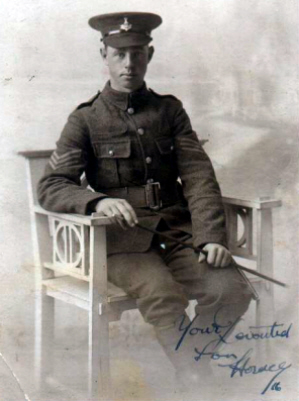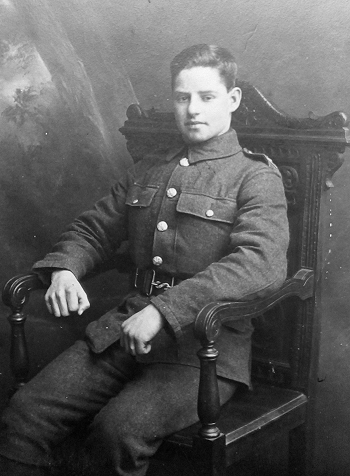
42316, King’s Own Yorkshire Light Infantry, 2nd Battalion
Leonard Brooke was born in Gawthorpe, Ossett in April 1897, the first child of milk-dealer Lionel Brooke and Mary Riley, who married in late 1895. The couple had seven children, but two had died before April 1911. Of the surviving children four were boys. Leonard was baptised on the 20th May 1897 at the Gawthorpe Methodist New Connexion Chapel.
In 1901 and 1911, the family were living in Gawthorpe, first on Cross Street and then later at 77, High Street. In the latter year, Leonard Brooke, aged 16, was working as a pit-boy, most probably at Low Laithes Colliery in Gawthorpe.
Unfortunately, Leonard Brooke’s army record has not survived and it isn’t known when he enlisted in the army. However, the The 2nd Battalion of KOYLI, in which he served at the time of his death was a regular army battalion and at the start of WW1, in August 1914, the battalion was based in Dublin as part of 13th Brigade in the 5th Division. On the 16th August 1914, they landed at Le Havre and then on the 28th December 1915 they transferred to 97th Infantry Brigade, 32nd Division.
They were in action in The Battle of Mons and the subsequent retreat, The Battle of Le Cateau, The Battle of the Marne, The Battle of the Aisne, The Battles of La Bassee and Messines and The First Battle of Ypres. In 1915 they were in action at The Second Battle of Ypres and the Capture of Hill 60. In autumn 1915, the Battalion was one of the units of 5th Division which were exchanged with units from the newly arrived volunteer 32nd Division, to stiffen the inexperienced Division with regular army troops, on the 28th of December 1915 they transferred to 97th Brigade in 32nd Division. In 1916 they were in action during the Battles of the Somme 1916, In 1917 they were involved in Operations on the Ancre and the pursuit of the German retreat to the Hindenburg Line.
Private Leonard Brooke was killed during what are now called the “Operations on the Ancre”, from the 11th January to the 13th March 1917 and specifically during the capture of Ten Tree Alley, near the town of Serre between the 10th and 13th February, in which 32 Division and the 2nd Battalion KOYLI were heavily involved.
“The enemy still held a considerable part of the upper reaches of the valley below Serre, and though his position there was uncomfortable, our own advance to Baillescourt Farm had left us with a long and somewhat shallow flank stretching westwards across the valley to the Beaumont Hamel spur. An advance northwards up the valley would greatly improve our own position and carry a stage further the menace to the German garrison in Serre. On the night of February 10-11, the 11th Bn. Border Regiment, the 2nd Bn. K.O.Y.L.I., and a company of the 16th Bn. Northumberland Fusiliers, all of the 97th Brigade, 32nd Division, effected the desired improvement, capturing three-quarters of a mile of German trench line known as Ten Tree Alley with over 200 prisoners at a cost of some 150 casualties.” 1
The War Diary of Charles Rooke of the 11th Border Regiment provides a bit more detail of the action that cost Private Leonard Brooke his life:
“Patrols were sent to establish communication with the 2nd K.O.Y.L.I. on the left. They were held up by a strongly held enemy post and Stokes mortars under Second-Lieutenant Simcocks, were used to suppress the enemy post.
The Germans counter attacked the position at 4.30 am., on 11th February 1917, from the NE , but the German attack wavered and was held up by rapid Rifle Fire and Lewis and Vickers Machine-Gun fire. On the left though, due to the cover of the smoke from the burning dug-out mentioned above, the enemy managed to get close up. A bomb fight ensued, but the attackers were repulsed. Then the area covered by the smoke was barraged with all available rifle grenades, artillery support called and delivered, along with Rifle, Lewis Gun and Vickers fire. Thus the enemy attack was completely broken and the German Infantry retired into the valley and back up the slope beyond. The rest of the day passed quietly, except for sniping and occasional outbursts of shell fire. Although observation had been much difficult due to by thick, low-lying mist, a patrol was then sent out and reported that the enemy was still on the left and was holding a post with 3 machine guns. When it became dark two attempts were made by the Reserve Company on the left to capture the enemy post above-mentioned, but these were unsuccessful.”
The “Ossett Observer” 2 had this obituary for Private Leonard Brooke:
“An Ossett Soldier’s Fate – Since February when Private Arthur Leonard Brooke, Gawthorpe, was reported missing, no news, throwing light on his fate, has reached his parents, until this week, when we handed to his father, Mr. Lionel Brooke, a teamer in the employ of the corporation, several photographs which had been sent to us by a sergeant in one of the salvage companies. This sergeant wrote us the following letter, which, though the news it contained was not hopeful, did credit to him:
‘Enclosed are four photographs picked up on one of the old battlefields after the burial party had been round. Knowing full well that many poor English soldiers are posted as missing, I felt it my duty to send these to you, and give you the assurance that the person on whom these were found is dead. One photograph bears an Ossett address, and that may give you a clue to the owner’s identity. Trusting this will dispel any doubts which may have rested on the minds of the relatives – Yours faithfully, etc.’
One of the photographs was of Private Brooke’s brother Horace (who is serving in France), and bore a written greeting from him: another was of his sister. His father knew he had them in his possession, along with a few other photographs (including two of local ministers) not yet recovered. Private Brooke, whose death must unfortunately be assumed, was in his early twenties, and took an active part in religious duties at Gawthorpe.”

Private Leonard Brooke was killed in action on the 11th/12th February 1917 in fighting at Ten Tree Alley, near Serre. He is buried at grave reference A. 3. at the Ten Tree Alley Cemetery, Puisieux , 3 Pas de Calais, France. Using the D919 from Arras to Amiens you will drive through the villages of Bucquoy, Puisieux then Serre-les-Puisieux (approximately 20 kilometres south of Arras). Immediately on leaving the village, take the small lane on the left hand side and continue for a further 1 kilometre where a CWGC signpost will lead you to Ten Tree Alley Cemetery on the left side.
Puisieux village was captured by British troops on the 28th February 1917, lost on the 26th March 1918 and recovered on the following 21st August. Ten Tree Alley was made by the V Corps (as Ten Tree Alley Cemetery No.2, V Corps Cemetery No.24) in 1917 and it stood beside a former German trench, captured by the 32nd Division on the night of the 10th-11th February 1917.
There are now nearly 70, 1914-18 war casualties commemorated in this site. Of these, over 20 are unidentified. The Cemetery covers an area of 250 square metres, without the access path and is enclosed by a rubble wall.

Above: Sergeant Horace Brooke,4 Leonard Brooke’s younger brother, born in 1898, and who survived WW1 despite seeing much action in the 38th Division. Is this picture like one of the photographs found on the body of Private Leonard Brooke and subsequently returned to his parents?
Horace enlisted in 1915 and was originally in the Yorkshire Regiment (better known as the ‘Green Howards’) and then he transferred to the Machine Gun Corps, 176th Machine Gun Company, 38th (Welsh) Division. He was awarded the Distinguished Conduct Medal (DCM) for bravery during WW1.
At the rank of Sergeant in 1917, he was court martialled and reduced to rank of Corporal only to be promoted back to sergeant in late October 1918. Horace Brooke was an art student and after WW1, he went on to become a commercial artist in Essex.
CWGC heastone photograph courtesy of Mark Smith
References:
1. Sir Douglas Haig’s command, December 19, 1915, to November 11, 1918 (1922), Page 194.
2. “Ossett Observer”, 30th June 1917
3. Commonwealth War Graves Commission web site
4. Picture provided by Chris Boydell, wife of Andrew Clay. Leonard Brooke was the great-uncle of Mr. Clay.